(and the engine, and the gas tank, and the differential...)
With the center of mass of the car lowered, we turned our attention to the other matters that...our attention needed to be turned to. Chief among these matters was the brakes. Initially, the brakes on the Volvo had performed masterfully even by new car standards, and considering that they were 40 year old solid discs up front with ancient drums out back, the fact that we could outbrake almost everyone seems fantastic. However, the previous owner had replaced all of the brake fluid with Kool-Aide, which boiled and blew out the caliper seals at some point during the day Sunday, thus reducing the brakes' effectiveness somewhat.

The front brakes and suspension. Unequal length A-arms! Also, note the lovely welded- up frame members, and the floor pan cum Montgomery Ward tractor hood.

When going through these pictures, I am sometimes struck by the artistic quality (clearly accidental) of them. This picture captures so much of what old car racing is about- odd, grubby parts, oily rags, bottles of penetrating lubricants, and massive beating instruments. And a wrench. The only thing missing is a big pile of greenbacks being incinerated. As the old adage goes, the best way to make a little money in racing is to start off with a lot of money.

Less artistic, but more technically interesting, is this picture of our calipers, disassembled. Three-piston calipers. Three? Who the heck thought of that? Someone named Girling, that's who. Hmm. Maybe _that's_ why our brakes worked so well...

Caliper Pistons.

While Rob disassembled and cleaned the calipers, and installed new seals and boots, Jamie and Anthony took a look at the rear brakes. Time having been short, we'd never even touched them for the first race- I mean, hey, the front brakes do like 80% of the stopping anyway. But as we were flushing the system of the horrible DOT 5 fluid it had been polluted with, we needed to tear into the aft binders as well this time. The drums on the back are attached to the axle by means of a large castle nut, and the drums themselves are actually pressed onto the axle shafts, and located with a key. A drum puller and BFH is required to extract the drums, and luckily our drums relented their grip on the axles without much fuss.

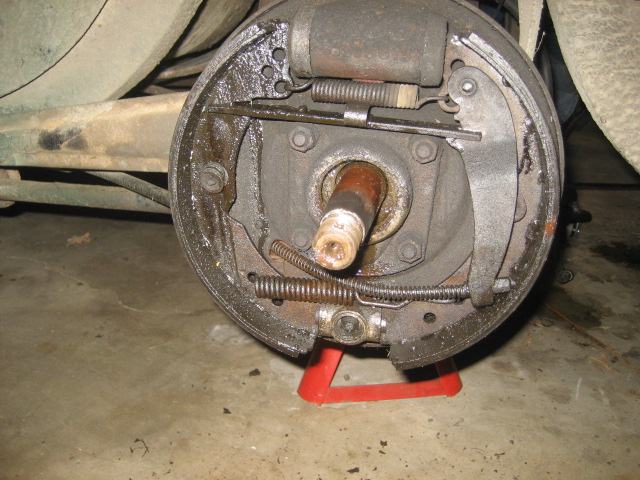
Yup, them's drum brakes. Anthony quipped at one point, "I've never even _seen_ drum brakes before!", which sparked off a discussion about the origins of drum brakes vs disc brakes. Discs, afterall, seem so much simpler, and as we all know, are much less prone to fading. But we reasoned automobile brakes derived from carriage brakes, which were essentially a block of wood pulled by a lever against the wheel. This ain't that much different. To be fair, though, I've driven a few cars with drum brakes at all four corners, and they don't stop frightfully badly. As long as you aren't doing more than about 40.
Brian showed up a little late to the party today, having been afflicted with a stomach bug (we think we went out partying the night before) He did show up though, after an alleged previous evening of vomit-spewing:

He was just in time to see us unbolt the rear wheel cylinders, and posed for this wonderful redux of last year's master cylinder moment:

No one questions Brian's sexual preferences, however. He has progeny to prove his heterosexualness.

This ugliness is a testimony my ham-fistedness, my laziness, and my welding ability. When loading the car on the trailer to take to the race last year, the low-hanging muffler caught on the cheap-o improvised ramp I had set up, and broke the exhaust manifold. As you can see, I welded the manifold back together, and despite cold-welding a cast iron bit subject to wild heat fluctuations, with no preheat, using a 110V welder with flux core wire, it held up for the whole race. However, in unloading the car back at my house, it again shattered. Luckily, I had a spare manifold, which we will be installing for this year's race.

With the intake manifold and carburetors removed. Having the intake and exhast on the same side of the engine was, in many regards, pretty poor design on Volvo's part, though it did reduce manufacturing costs, I'm sure. Oh well. The rest of the car is designed so well, and the engine is pretty robust in most other regards, so we'll give them a pass on this one. By the way, notice the _generator_ on the lower right. Yeah. I'm pretty sure ours was the only car at last year's race with a freaking generator. And points. And dual carbs. And a single pot master cylinder. We are just a cornucopia of 1950's technology.

The Glorious SU carburetors and intake. British fuel mixing at its finest!
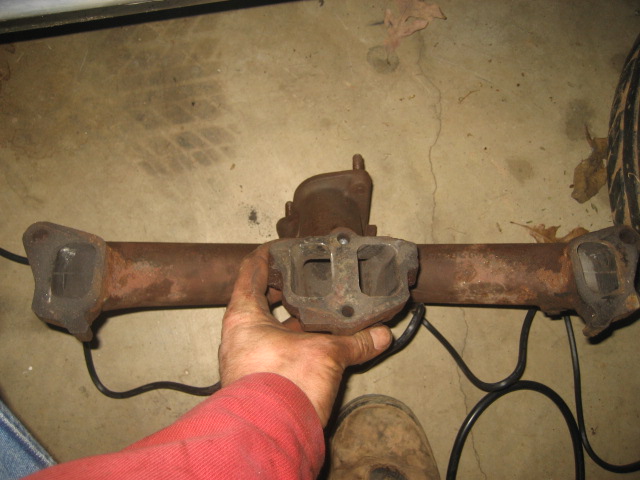
The new (well, non-broken anyway) manifold. I was somewhat late arriving to Rob's garage today, on account of the fact that I had to extract this gem from another B-series Volvo engine, and the nuts securing it to the block were empowered with the strength of 40 years of rust. However, the manifold itself is solid, and I even improved it by dremelling out the ports to make them flow better. That's gotta be worth, what, 30 horsepower?
The new manifold and same old intake bolted back on to the engine in the same order in which is was removed, and quite easily. We even re-used the gasket. This saved us about a dozen dollars. We'd replaced the gasket before the last race, anyway, so it was in pretty good shape. One thing I have to remember for next time: bolt the dang exhaust manifold on BEFORE installing the intake, DON'T try to bolt them on together. Yeah, the nuts on the ends have to go in with both parts installed, but the individual holes on the exhaust manifold are nearly impossibly to wrench on with the intake installed.
Next came the fuel tank...

This is not the fuel tank we ran at the last race. That fuel tank was full of rust, caused us many headaches and lost hours of racing, and was ditched quickly in favor of this nice, lightly used cell. The fact that it was free was icing on the cake, though being "safety" related, it wouldn't really count against our $500 limit. But we're poor (heck, this is why LeMons is so attractive for us, since we can't be outspent TOO horribly by the other teams) and free speaks to our collective cheapskate tendencies. There was some discussion about mounting it on the roof, and ditching the fuel pump, for reliability. However, this was decided against, due to the fact that it would raise the center of gravity of the car, and due to the fact that, while this wouldn't necessarily be in violation of the letter of any safety rules, it would definitely more than bend them in spirit.
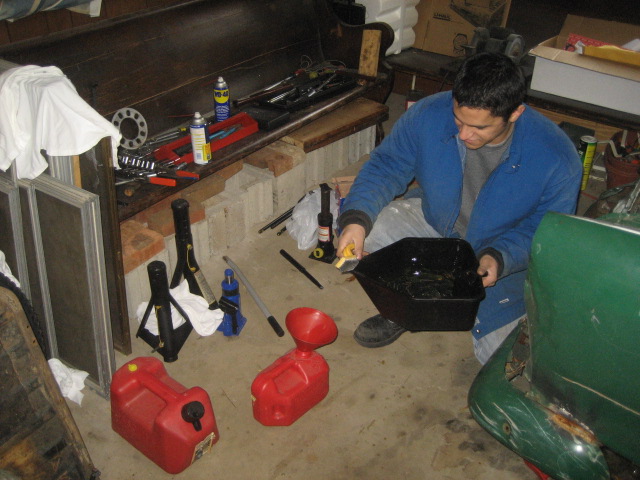
When the time came to remove the old tank, it was discovered that it still contained nearly a full load of fuel. Here, Anthony drains the tank. Unfortunately, Rob only had lots of very very little jerry cans, so we were forced to run about finding things to put the fuel into. Motorcycles, lawnmowers, leaf vacuums, Brian's mouth, the weeds next to the garage...
Just kidding. The Tunachuckers pride themselves on being highly sensitive to the ecovironment. We even recycled our race car.


Here's where the tank used to live. The fuel cell will have to fit in here, somehow.
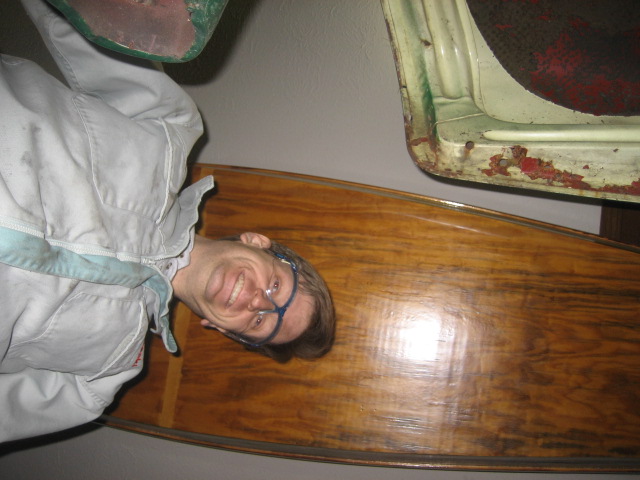
The view through the trunk floor, sans fuel tank. And Jamie balances a finely polished canoe on his head.
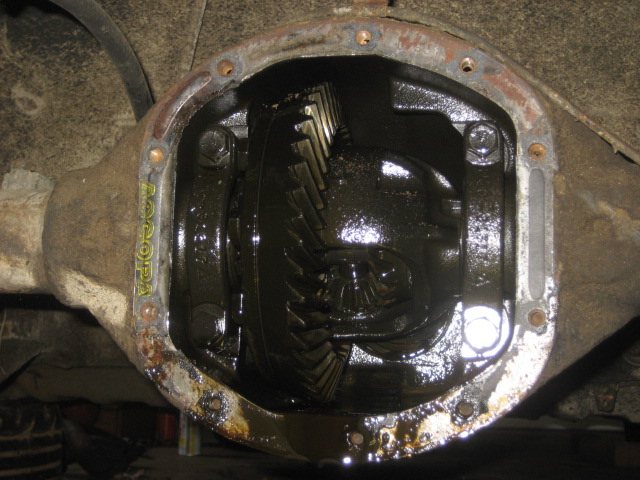
Something else we never looked at prior to the first race was the rear differential. Once again, Volvo utilized only the best, as this Dana-sourced rear evidences. Despite having over 40 years and mutliple-hundred-thousand miles on it (including a few hundred miles around a certain race track), the ring and pinion looked absolutely pristine. Another benefit of the Dana rear is that ring and pinion sets are plentiful, easy to change, and available reasonably. With the 4.10 ratio currently installed, we almost never shifted above 3rd gear. The plan is to scour eBay and the list of Craig for a numerically lower ratio- preferably something around a 4.56 or a 4.88- to get us into the 3-4 shift area coming our of the turns. Our 2nd gear synchros are pretty beat, too. More on this during later work sessions...

How this happend is a mystery, truly and utterly. The right lower A-arm in the front suspension was bent, pretty severely., at the ear. The bushing was shot, and the bolt upon which the A-arm pivots was bent, too. In order to remove the old A-arm, the A-arm had to be sawed off, and the bolt cut, too.

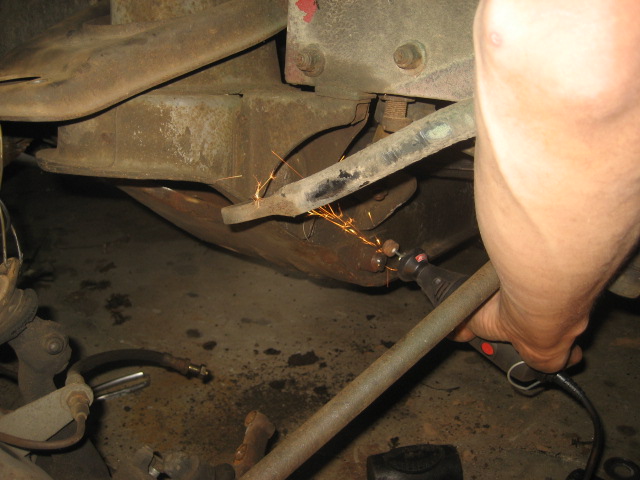
After cutting off the A-arm and whaling on the bolt with the sledge, the end of the bolt had mushroomed so badly it had to be ground off before it could be extracted from the front suspension sub frame. Jamie and Brian worked at this together, coordinating hits and performing all manner of mechanical ballet to get the front suspension apart.

More grinding. This Dremel tool has been quite a wonder for us- from cutting springs to removing broken suspension bits to cleaning plaque from Anthony's teeth, it has more than proved its worth.
Below, some results of Brian's hammering and grinding:

Ain't no time for bleeding!

The new A-arm! Oh, crap, its for the wrong side! Well, better luck next time. This one will go back to the stash-o-crap in my barn, and I'll have to dig out the correct one. As Brian points out, this is another one of those quasi-artistic pictures that encapsulates low-buck car work. An A-arm, a broken exhaust manifold, an SU carburetor, a clipboard, some random tubing, and a shiny new slide hammer kit hastily purchased at Napa to remove the rear axles, as shown below:

Axles removed, we counted the splines on the shafts- 10- which indicates a Dana 27 rear. Also, we checked the bearings, races,etc. Everything looks amazing, and about 2 to 30 times more robust than it needs to be. Go Swedish overengineering.

This little guy crawled out of somewhere on the car. I'm pretty sure he dropped out of a pine tree in my backyard. There seem to be quite a few spiders in the car- either that, or Rob secretly breeds them in his garage. We may have to race with a can of Raid strapped next to the fire extinguisher.

One of the more fun parts about the 24 Hours Of LeMons is that many teams decorate their cars with a theme. The stuffed animals in the picture above hint to our theme this year, to be disclosed at some later date.
That's about it for work day #2. We got the exhaust manifold fixed, we got the calipers sort-of rebuilt (missing seals in the rebuild kits- grrr!), and we got alot of stuff taken apart.